-

中班体育教案:没有窝的小兔
准备兔头饰若干,大灰狼头饰一个,磁带。 过程一、开始部份1.小兔子(幼儿)分散站在场地中间,在兔妈妈(教师)的带领下做自编的小兔操节。2.队列练习:四队走——两队走——大圆走——左右分队走——一队一队走。二、基本部份1.介绍游戏名称。2.游戏玩法:选出两名幼儿分别当没有窝的小兔和大灰狼,其余的人按三人分成几组,两人围成圈,一人当窝中的兔,每组相距3—6步,
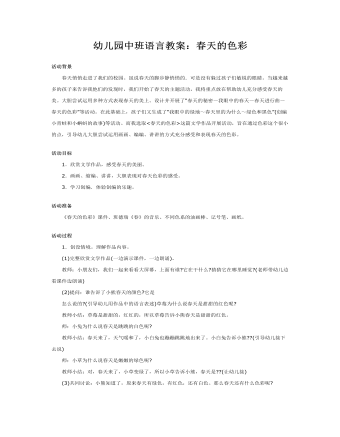
幼儿园中班语言教案:春天的色彩
活动目标1.欣赏文学作品,感受春天的美丽。2.画画、缩编、讲讲,大胆表现对春天色彩的感受。3.学习创编.体验创编的乐趣。活动准备 《春天的色彩》课件、班德瑞《春》的音乐、不同色系的油画棒、记号笔、画纸。活动过程1.创设情境。理解作品内容。(1)完整欣赏文学作品(一边演示课件,一边朗诵)。 教师:小朋友们,我们一起来看看大屏幕,上面有谁?它在干什么?猜猜它在哪里睡觉?(老师带幼儿边看课件边朗诵)
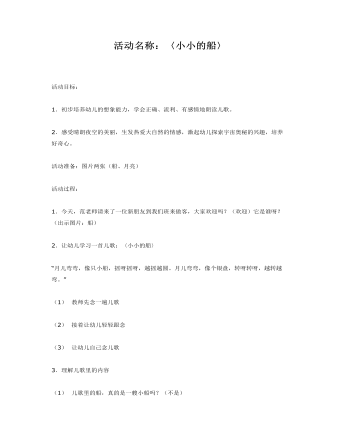
幼儿园中班语言教案:小小的船
2.感受晴朗夜空的美丽,生发热爱大自然的情感,激起幼儿探索宇宙奥秘的兴趣,培养好奇心。活动准备:图片两张(船、月亮)活动过程:1.今天,范老师请来了一位新朋友到我们班来做客,大家欢迎吗?(欢迎)它是谁呀?(出示图片:船)2.让幼儿学习一首儿歌:〈小小的船〉“月儿弯弯,像只小船,摇呀摇呀,越摇越圆。月儿弯弯,像个银盘,转呀转呀,越转越弯。”(1) 教师先念一遍儿歌(2) 接着让幼儿轻轻跟念(3) 让幼儿自己念儿歌
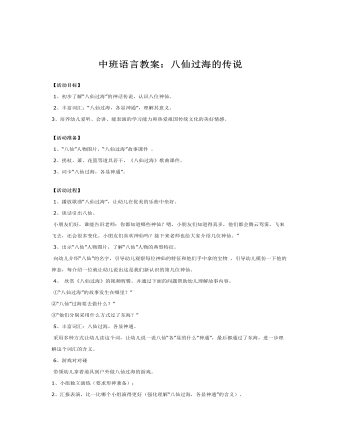
中班语言教案:八仙过海的传说
3、培养幼儿爱听、会讲、能表演的学习能力和热爱祖国传统文化的美好情感。【活动准备】 1、“八仙”人物图片,“八仙过海”故事课件。 2、拐杖、萧、花篮等道具若干,《八仙过海》歌曲课件。 3、词卡“八仙过海,各显神通”。【活动过程】 1、播放歌曲“八仙过海”,让幼儿在优美的乐曲中坐好。 2、谈话引出八仙。 小朋友们好,谁能告诉老师:你都知道哪些神仙?嗯,小朋友们知道得真多,他们都会腾云驾雾,飞来飞去,还会很多变化。小朋友们喜欢神仙吗?接下来老师也给大家介绍几位神仙。” 3、出示“八仙”人物图片,了解“八仙”人物的典型特征。 向幼儿介绍“八仙”的名字,引导幼儿观察每位神仙的特征和他们手中拿的宝物,引导幼儿模仿一下他的神态,每介绍一位就让幼儿说出这是我们新认识的第几位神仙。
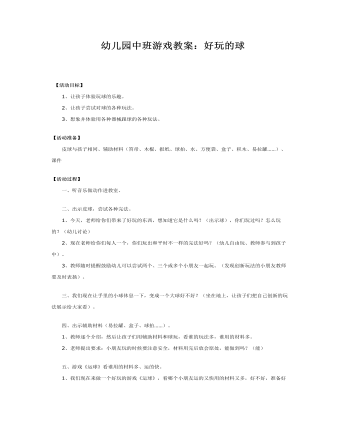
幼儿园中班游戏教案:好玩的球
2、让孩子尝试对球的各种玩法。3、想象并体验用各种器械跟球的各种玩法。【活动准备】 皮球与孩子相同、辅助材料(笤帚、木棍、报纸、球拍、水、方便袋、盒子、积木、易拉罐……)、课件【活动过程】 一、听音乐做动作进教室。 二、出示皮球,尝试各种完法。1、今天,老师给你们带来了好玩的东西,想知道它是什么吗?(出示球),你们玩过吗?怎么玩的?(幼儿讨论)2、现在老师给你们每人一个,你们玩出和平时不一样的完法好吗?(幼儿自由玩、教师参与到孩子中)。3、教师随时提醒鼓励幼儿可以尝试两个、三个或多个小朋友一起玩。(发现创新玩法的小朋友教师要及时表扬)。
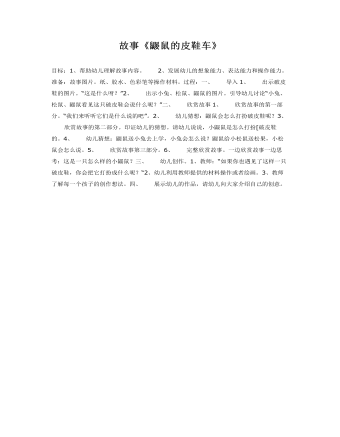
中班语言教案 鼹鼠的皮鞋车
2、发展幼儿的想象能力、表达能力和操作能力。准备:故事图片。纸、胶水、色彩笔等操作材料。过程:一、 导入1、 出示破皮鞋的图片。“这是什么呀?”2、 出示小兔、松鼠、鼹鼠的图片。引导幼儿讨论“小兔、松鼠、鼹鼠看见这只破皮鞋会说什么呢?”二、 欣赏故事1、 欣赏故事的第一部分。“我们来听听它们是什么说的吧”。2、 幼儿猜想:鼹鼠会怎么打扮破皮鞋呢?3、 欣赏故事的第二部分。印证幼儿的猜想。请幼儿说说,小鼹鼠是怎么打扮[破皮鞋的。
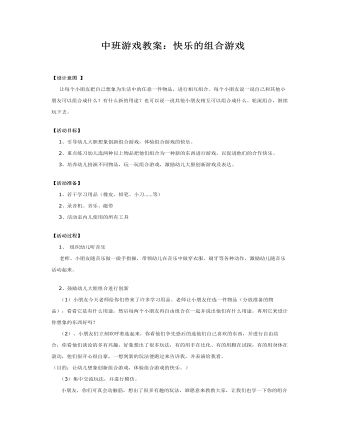
中班游戏教案:快乐的组合游戏
【活动目标】 1、引导幼儿大胆想象创新组合游戏,体验组合游戏的快乐。 2、重点练习幼儿选两种以上物品把他们组合为一种新的东西进行游戏,以促进他们的合作快乐。 3、培养幼儿扮演不同物品,玩一玩组合游戏,激励幼儿大胆创新游戏及表达。 【活动准备】 1、若干学习用品(橡皮、铅笔、小刀……等) 2、录音机、音乐、磁带 3、活动室内儿使用的所有工具 【活动过程】 1、 组织幼儿听音乐 老师、小朋友随音乐做一做手指操,带领幼儿在音乐中做穿衣服、刷牙等各种动作,激励幼儿随音乐活动起来。 2、鼓励幼儿大胆组合进行创新 (1)小朋友今天老师给你们带来了许多学习用品。老师让小朋友任选一件物品(分放准备的物品),看看它是有什么用途。然后每两个小朋友再自由组合在一起并说出他们有什么用途。再用它来设计你想象的东西好吗? (2)、小朋友们立刻欢呼着选起来,你看他们争先恐后的选他们自己喜欢的东西,并进行自由结合,你看他们谈论的多有兴趣,好象想出了很多玩法,有的用手在比化、有的用脚在试探,有的用身体在滚动,他们很开心很自豪,一想到新的玩法便跑过来告诉我,并表演给我看。 (目的:让幼儿想象创新组合游戏,体验组合游戏的快乐。)
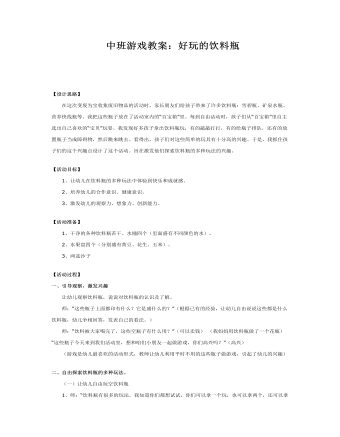
中班游戏教案:好玩的饮料瓶
【活动目标】1、让幼儿在饮料瓶的多种玩法中体验到快乐和成就感。2、培养幼儿的合作意识、健康意识。3、激发幼儿的观察力、想象力、创新能力。【活动准备】1、干净的各种饮料瓶若干、水桶四个(里面盛有不同颜色的水)。2、水果盘四个(分别盛有黄豆、花生、玉米)。3、两盆沙子【活动过程】一、引导观察,激发兴趣 让幼儿观察饮料瓶,说说对饮料瓶的认识及了解。 师:“这些瓶子上面都印有什么?它是盛什么的?”(根据已有的经验,让幼儿自由说说这些都是什么饮料瓶,幼儿争相回答,发表自己的看法。) 师:“饮料被大家喝完了,这些空瓶子有什么用?”(可以卖钱)(我妈妈用饮料瓶做了一个花瓶)“这些瓶子今天来到我们活动室,想和咱们小朋友一起做游戏,你们高兴吗?”(高兴) (游戏是幼儿最喜欢的活动形式,教师让幼儿利用平时不用的这些瓶子做游戏,引起了幼儿的兴趣)

中班综合教案小乌龟的样子
2、尝试用绘画的形式表现小乌龟的动态。 活动准备: 小乌龟若干、各种包有海绵的瓶子若干、颜料、油画棒;录像与电脑、 音乐录音带. 回忆模仿——绘画表现——活动延伸 活动过程: 一、引导幼儿讲讲小乌龟,模仿小乌龟的动作: ——这些天,我们班来了许多小客人,它们是谁? ——它们长什么样子?(有壳、四条腿、头、尾巴、壳上有花 纹)
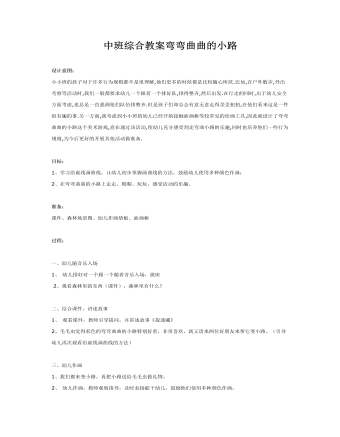
中班综合教案弯弯曲曲的小路
目标:1、学习沿虚线画曲线,让幼儿初步掌握画曲线的方法,鼓励幼儿使用多种颜色作画;2、在弯弯曲曲的小路上走走、爬爬、玩玩,感受活动的乐趣。 准备:课件、森林场景图、幼儿作画垫板、油画棒 过程: 一、幼儿随音乐入场1、幼儿排好对一个跟一个随着音乐入场,就座 2、观看森林里的东西(课件),森林里有什么?
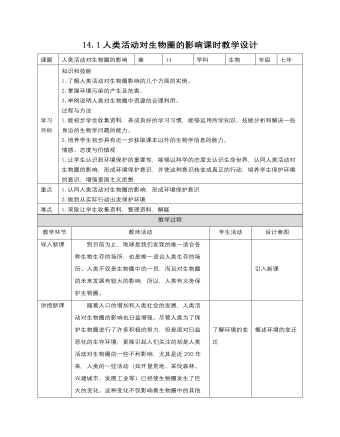
初中生物北师大版七年级下册《第14章第1节人类活动对生物圈的影响》教案
知识和技能 1.了解人类活动对生物圈影响的几个方面的实例。 2.掌握环境污染的产生及危害。 3.举例说明人类对生物圈中资源的合理利用。 过程与方法 1.能初步学会收集资料,养成良好的学习习惯,能够运用所学知识、技能分析和解决一些身边的生物学问题的能力。 2.培养学生初步具有近一步获取课本以外的生物学信息的能力。 情感、态度与价值观 1.让学生认识到环境保护的重要性,能够以科学的态度去认识生命世界,认同人类活动对生物圈的影响,形成环境保护意识,并使这种意识转变成真正的行动,培养学生保护环境的意识,增强爱国主义思想1.认同人类活动对生物圈的影响,形成环境保护意识 2.做到从实际行动出发保护环境1.采取让学生收集资料,整理资料,解疑

北师大初中七年级数学下册平行线的性质教案
解析:平行线中的拐点问题,通常需过拐点作平行线.解:(1)∠AED=∠BAE+∠CDE.理由如下:过点E作EG∥AB.∵AB∥CD,∴AB∥EG∥CD,∴∠AEG=∠BAE,∠DEG=∠CDE.∵∠AED=∠AEG+∠DEG,∴∠AED=∠BAE+∠CDE;(2)同(1)可得∠AFD=∠BAF+∠CDF.∵∠BAF=2∠EAF,∠CDF=2∠EDF,∴∠BAE+∠CDE=32∠BAF+32∠CDF,∴∠AED=32∠AFD.方法总结:无论平行线中的何种问题,都可转化到基本模型中去解决,把复杂的问题分解到简单模型中,问题便迎刃而解.三、板书设计平行线的性质:性质1:两条平行线被第三条直线所截,同位角相等;性质2:两条平行线被第三条直线所截,内错角相等;性质3:两条平行线被第三条直线所截,同旁内角互补.平行线的性质是几何证明的基础,教学中注意基本的推理格式的书写,培养学生的逻辑思维能力,鼓励学生勇于尝试.在课堂上,力求体现学生的主体地位,把课堂交给学生,让学生在动口、动手、动脑中学数学
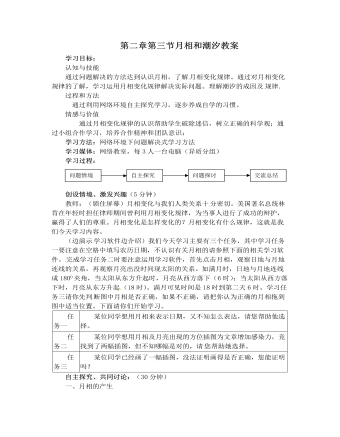
人教版高中地理选修1第二章第三节月相和潮汐教案
创设情境、激发兴趣(5分钟)教师:(锁住屏幕)月相变化与我们人类关系十 分密切。美国著名总统林肯在年轻时担任律师期间曾利用月相变化规律,为当事人进行了成功的辩护,赢得了人们的尊重。月相变化是怎样变化的?月相变化有什么规律,这就是我们今天学习内容。(边演示 学习软件边介绍)我们今天学习主要有三个任务,其中学习任务一要注意在空格中填写农历日期,不认识有关月相的请参照下面的相关学习软件。 完成学习任务二时要注意运用学习软件,首先点击月相,观察日地与月地连线的关系,再观察月亮出没时间现太阳的关系。如满月时,日地与月地连线成1800夹角,当太阳从东方升起时,月亮从西方落下(6时);当太阳从西方落下时,月亮从东方升起 (18时)。满月可见时间是18时到第二天6时。学习任务三请你先判 断图中月相是否正确,如果不正确,请把你认为正确的月相拖到图中适当位置。下面请你们开始学习。

人教版新目标初中英语八年级下册He said I was hard-working教案2篇
This activity introduces some new vocabulary and provide oral practice using the target language.Task 1 . Ask four students to stand in front of the class, and the teacher asks them the following questions as a reporter.1.What are you going to do when you grow up?2.What are you going to do next week?3.What are going to do after school?The students will give different answers, then ask a good student to report what they said.I am going to e a doctor.What did she say?----------She said she was going to be a doctor.I am going to have a party on Friday night.What did he say?-------He said he was going to have a party on Friday night.I am going to do my homework.What did she say ?------ She said she was going to do her homework.I am going home after school.What did she say?-----She said she was going home after school.Say In this unit we are going to learn to use words like to report what someone said.Task 2. Read the instructions. Then ask a student to read the four questions. And write the words on the Bb. Explain what soap opera is.Task 3. Ask the students to Look at the pictures, point out the TV screens in the picture. Ask one girl to read what Marcia said.What did Marcia say? She said She said she was having a surprise party for Lana on Friday night. Repeat the other pictures in the same way.Activity3. Listen and number the pictures in activity 1a.

人教版新目标初中英语七年级下册How was your weekend教案2篇
Teaching Goal:1. General aims:Talk about recent past events2. Particular aims:A. Language Focus.Talk about recent past events and think of the past events.B. Language goalsHow was….?It was …What did …do over the weekend?C. Language structures:(1). How was your weekend? I was great. Pay attention to no form.(2). What did you do over the weekend? I played soccer. We went to the beach.D. Useful words and phrases:Words: was, did, went, beach, over, project, test, wasn’t, false, number, geography, spend, week, most, mixture, their, had, little, cook, read, saw, change, everyone, sit, sat, no, anythingPhrases: did one’s homework, played soccer, cleaned my room, went to the beach, played tennis, went to the movies, on Saturday morning, over the weekend, cook … for, what about, do some reading, have a party, talk show, go shoppingE. Grammar language:Present simple past tenseRegular and irregular verbsF. Learning strategies:Tour and holidaysG. Interdiscipinary:H. Emotion and manner:Teaching time: 5 periodsTeaching procedures:Period One教学步骤、时间 教师活动 学生活动 媒体应用Step 1Free talk 3’ Ask some questions like:Who’s on duty today?What’s the weather like? Answer and talk about something.让同学们回答下列问题1. Do you like weekend? (Let some students answer)It takes them three minutes to talk about the question.2. Why do you like weekend? (let the students answer) Most of the students like the weekend此时教师用汉语问:“在周末期间问你干了什么?这句话用英语这么回答?Let the students guess.At last the teacher give them right answer3. What did you do over the weekend?(板书、学习)

人教版新目标初中英语七年级下册Where is the post office教案2篇
Period 2 (3a----Section B 2c)Preview(Pre-task): Key points: What laAdd another information about their pen pals----their language on the cardnguage does she/he speak?She/He speaks....Does she/he have any brothers and sisters? Does she/he speak English?Preview(Pre-task): Add another information about their pen pals----their language on the cardKey points: What language does she/he speak?She/He speaks....Does she/he have any brothers and sisters? Does she/he speak English?Step 1 Revision1.Revisionand dictation of the new words 2.Revise the drills they learned yesterday.(by pairwork and grammar exercise)Step 2 Leading-inT has a conversation with one student. The conversation is following:---Do you have a pen pal?---Yes, I do.---What's your pen pal's name? ---His/Her name is....---Where is your pen pal from? ---He/She is from...---Where does he/she live? ---He/She lives in....---What language does he/she speak?He/She speaks...Write the new words on the Bb. They are following: EnglishChineseJapaneseFrenchStep 3 LearnLearn the new words with the whole class.Finish 3a with the students3b Pairwork T still does an example with one student Then the Ss practise in pairs. The example is following:--Curry Muray is my pen pal. He is from the United States.---What language does he speak?

人教版新目标初中英语七年级下册Don’t eat in class教案2篇
Don’t fight. =You can’t fight. (板书,教读)教师把这些句子板书在黑板上,并请学生大声整齐地读祈使句和“can’t”句型,并让学生注意两种句型表达形式的不同和转换,“Don’t …=You can’t…”;并对学生说:These are our school rules. (板书,教读) You can’t break the school rules. Don’t break the school rules.(板书,教读)步骤3 :Practicea. T: Now, each of the students is breaking one of these rules.Please finish 1a.学生看图,完成1a的内容,检查答案并大声朗读校规。b. 听录音,完成1b,选出四位学生都违反了哪条校规;听之前,学生要读会英文名。c. 请两位学生朗读1c部分的句型;要求学生两人一组对话表演,SA扮演外校转来新生,SB告知本校校规。(学生可经过讨论,多说出他们想到的校规,不必只限于书上;教师应给予帮助)2) 第二课时(2a~4)步骤1 :warming up of revisionT: What are the rules at your school?学生使用“can”或祈使句表达各条校规;其中老师可引出“eat in the cafeteria outside”的表达。步骤2 :Practicea.T: Christina is an exchange student. She doesn’t know the rules. Let’s listen, what activities they’re talking about?学生听第一遍时,完成2a;第二遍时,完成2b;b. 请学生领读2c部分,看着2a完成的表格,理解2c活动的要求;分成小组针对2a进行问答;

人教版新目标初中英语七年级下册I want to be an actor教案2篇
三、教学建议第一课时:1. Lead in (Vocabulary)A) Before class, teacher should collect some pictures of working places. For example: Bank, TV Station, Restaurant, Police Station, Hospital ...B) In class, show students the pictures (PowerPoint, OHP). Ask students to tell the name of the working places and the name of the jobs.Shop assistant, doctor, actor, reporter, police office, waiter, bank clerk, studentC) Do exercise 1a and 3a.2. Bingo GameAsk groups of students to make up pairs of cards with a job on one and the related workplace on the other. For example, waiter / restaurant, teacher / school, doctor / hospital. Encourage students to use both the job / workplace combinations in the book and the ones that students came up during class discussions. Be sure they have twice as many sets of cards as there are students in the group. They can make two sets of cards for a single job / workplace, if necessary. Then have each group mix up its set of cards and hand their cards out in random order. Each time a student gets a pair of cards that match, he or she can lay these cards down. The goal is to have no cards in your hand at the end.3. Task OneA) Ask students to work in pairs and ask the partner what does he / she want to be in the future.e. g. :What do you / does he / does she want to be?I want to be a.Why?Because it's (adj).B) Vocabulary: Section B, 1a4. Homework 1.2.

人教版新目标初中英语七年级下册It’s raining教案2篇
1 Each group choose one place to describe and what you are doing in it Choose one place, and describe what they are doing 2 Move around the room and give suggestions Talk about it and write it down 3 Ask one to show their works and act it Choose one of each group to make a report 4 Evaluate the best group and the best reporter Choose the best one Homework Ask your friends their ideal place and write about it教学反思:新课程标准中强调学生在课堂中的主体地位,在综合课中他们的主体地位就更加突出。在各个活动中给不同程度的学生不同层次的任务,让各层面的学生都有表现发挥的机会,从而产生对英语的兴趣。使用照片图片多媒体来辅助教学,效果更好。同时让了解其他国家风景,风俗的同学介绍ideal place,增加学生的背景知知识,实现跨学科交流的目的。教案点评:采用任务型教学模式,在各个活动中给不同程度的学生不同层次的任务,让各层面的学生都有表现发挥的机会,从而产生对英语的兴趣。使用照片图片多媒体来辅助教学,效果更好。让了解其他国家风景,风俗的同学介绍ideal place,增加学生的背景知识,实现跨学科交流的目的。

人教版新目标初中英语七年级下册Why do you like koalas教案2篇
单元整体说明(一)单元教材分析本单元的核心话题是描述动物和表达个人喜好,以及句式why do you like…? Because…。这也是本单元的教学重点。通过本单元的学习,学生应能较流利地运用所学词汇和句型描述动物,表达个人喜好。(二)单元知识结构1.词汇动物名称 tiger, elephant, koala, dolphin, etc.词汇描述性形容词: smart, cute, ugly, clever, shy, etc.国家名: Australia, South Africa2.句型Why do you like koala hears? Because they are cute.Where are pandas from? They're from China.What animals do you like? I like dolphins.(三)单元整体目标1.Master the vocabulary2.Master and use: Why do you like koalas? Because they am cute.Where are pandas from? They're from China.What animals do you like? I like dolphins.(四)单元教学重难点一览(五)单元学情分析学生此前已经学过由why, where, what 引导的特殊疑问句句型,具有了学习本单元知识的认知前提。形形色色的动物能激发学生的好奇心,产生了解它们的欲望,这有利于本单元知识的教学和学生学习兴趣的培养。